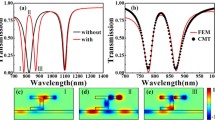Abstract
We propose a π-network transmission line model to investigate plasmonic metal-dielectric-metal (MDM) waveguides side-coupled with cavity structures. This model can effectively describe the transmission characteristics as a function of coupling distance in our proposed structures. And the π-network transmission line model is promoted to describe transmission spectra and scattering parameters in infinite element structures and periodic structures, which are confirmed by the finite-difference time-domain (FDTD) simulation results. In addition, the slow-light effects in waveguide side-coupled with periodic cavity structures are researched in our paper. And we first compare the slow-light effects in the plasmonic waveguide side-coupled with cavity structures and stub structures. These observations could be helpful to fundamental research and applications for integrated plasmonic devices.





Similar content being viewed by others
References
Raether H (1998) Surface plasmons on smooth and rough surfaces and on gratings. Springer Tracts in Modern Physics 111
Barnes WL, Dereux A, Ebbesen TW (2003) Surface plasmon subwavelength optics. Nature 424:824
Hassan K, Bouhelier A, Bernardin T, Colas-des-Francs G, Weeber JC, Dereux A (2013) Momentum-space spectroscopy for advanced analysis of dielectric-loaded surface plasmon. Phys Rev B 87:195428
Yun BF, Hu GH, Cui YP (2010) Theoretical analysis of a nanoscaleplasmonic filter based on a rectangular metalinsulator-metal waveguide. J Phys D Appl Phys 43:385102
Zand I, Abrishamian MS, Berini P (2013) Highly tunable nanoscale metal-insulator-metal split ring core ring resonators (SRCRRs). Opt Express 21:79
Cao GT, Li HJ, Deng Y, Zhan SP, He ZH, Li BX (2014) Systematic theoretical analysis of selective-mode plasmonic filter based on aperture-side-coupled slot cavity. Plasmonics 9:1163
Dionne JA, Sweatlock LA, Atwater HA (2006) Plasmon slot waveguides: towards chip-scale propagation with subwavelength-scale localization. Phys Rev B 73:035407
Huang QD, Liang RS, Chen PX, Wang S, Xu Y (2011) High resonant transmission contrast filter based on the dual side-coupled cavities plasmonic structure. J Opt Soc Am B 28:1851
Lu H, Liu XM, Mao D, Wang GX (2012) Plasmonic nano sensor based on Fano resonance in waveguide-coupled resonators. Opt Lett 37:3780
Cao GT, Li HJ, Zhan SP, He ZH, Guo ZB, Xu XK, Yang H (2014) Uniform theoretical description of plasmon-induced transparency in plasmonic stub waveguide. Opt Lett 39:216
He ZH, Li HJ, Zhan SP, Cao GT, Li BX (2014) Combined theoretical analysis for plasmon-induced transparency in waveguide systems. Opt Lett 39:5543
Xiao SS, Liu L, Qiu M (2006) Resonator channel drop filters in a plasmon-polaritons metal. Opt Express 14:2932
Zhan SP, Li HJ, Cao GT, He ZH, Li BX, Xu H (2014) Theoretical analysis of plasmon-induced transparency in ring-resonators coupled channel drop filter systems. Plasmonics 9:1431
Asanka P, Ivan DR, Malin P, Haroldo TH, Govind PA (2010) Improved transmission model for metal-dielectric-metal plasmonic waveguides with stub structure. Opt Express 18:6191
Wang GX, Lu H, Liu XM (2012) Trapping of surface plasmon waves in graded grating waveguide system. Appl Phys Lett 101:013111
Zhong ZJ, Xu Y, Lan S, Dai QF, Wu LJ (2010) Sharp and asymmetric transmission response in metal-dielectric-metal plasmonic waveguides containing Kerr nonlinear media. Opt Express 18:79
Zhang Q, Huang XG, Lin XS, Tao J, Jin XP (2009) A subwavelength coupler-type MIM optical filter. Opt Express 17:7549
Rezaei M, Jalaly S, Miri M, Khavasi A, Fard AP, Mehrany K, Rashidian B (2012) A distributed circuit model for side-coupled nanoplasmonic structures with metal-insulator-metal arrangement. IEEE Sel Top Quantum Electron 18:1692
Rezaei M, Miri M, Khavasi A, Mehrany K, Rashidian B (2012) An efficient circuit model for the analysis and design of rectangular plasmonic resonators. Plasmonics 7:245
Bahadori M, Eshaghian A, Hodaei H, Rezaei M, Mehrany K (2013) Analysis and design of optical demultiplexer based on arrayed plasmonic slot cavities: transmission line model. IEEE Photon Tech Lett 25:784
Kocabas SE, Veronis G, Miller DAB, Fan SH (2008) Transmission line and equivalent circuit models for plasmonic waveguide components. IEEE J Sel Top Quantum Electron 14:1462
Ramo S, Whinnery JR, Duzer TV (1994) Fields and waves in communication electronics, 3rd edn. Wiley, New York
Veronis G, Fan SH (2005) Bends and splitters in metal-dielectric-metal subwavelength plasmonic waveguides. Appl Phys Lett 87:131102
Parker MA (2005) Physics of optoelectronics. CRC Press, Florida
Acknowledgments
This work was funded by the Fundamental Research Funds for the Central Universities of Central South University under Grant No. 72150050429 and the National Natural Science Foundation of China under Grant No. 61275174.
Author information
Authors and Affiliations
Corresponding author
Rights and permissions
About this article
Cite this article
He, Z., Li, H., Zhan, S. et al. π-Network Transmission Line Model for Plasmonic Waveguides with Cavity Structures. Plasmonics 10, 1581–1585 (2015). https://doi.org/10.1007/s11468-015-9981-7
Received:
Accepted:
Published:
Issue Date:
DOI: https://doi.org/10.1007/s11468-015-9981-7




